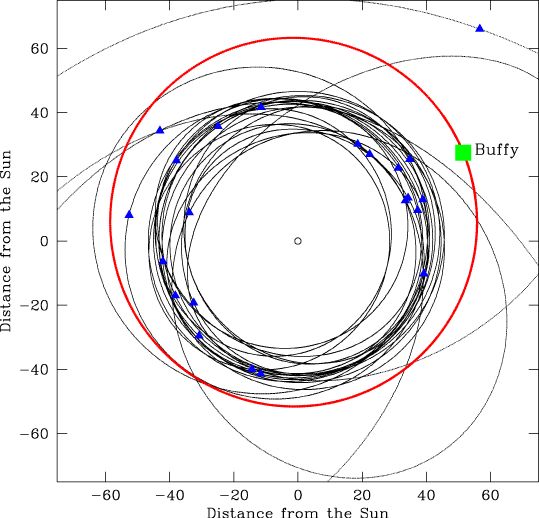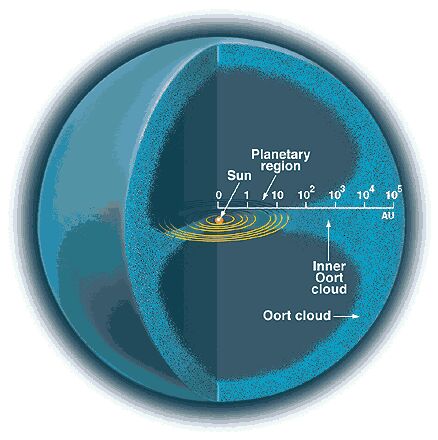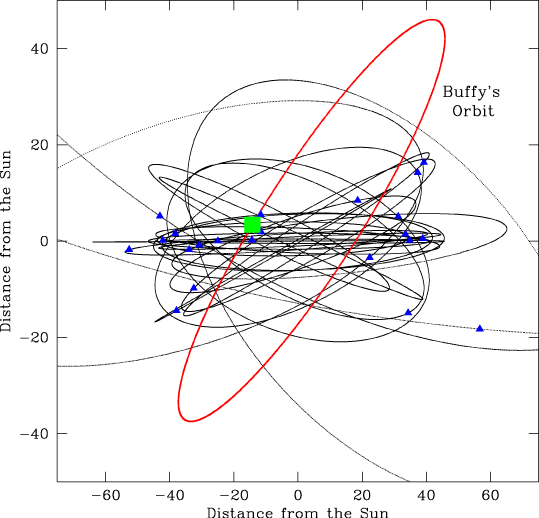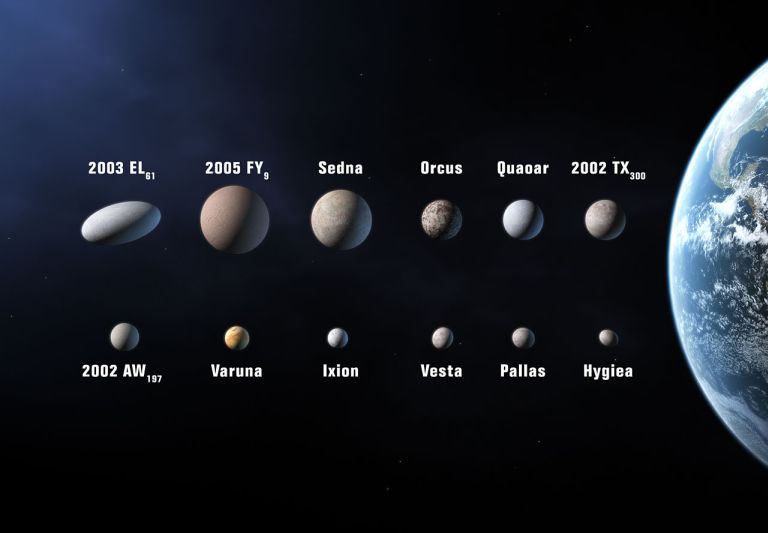|
Enigmas in Our Solar System New Planets Discovered |
||
|
.
For an
Edgeworth -Kuiper
object (EKO), 2004 XR 190 ("Buffy") has an
unusually circular orbit (more).
A
view of Buffy's and other Kuiper belt object
orbits, each in the plane
of their own orbit, to show the separation
between Buffy and other Kuiper
belt objects. At the center of the plot, the
small circle at center shows
Earth's orbit for scale.
On August 24, 2006, the International Astronomical Union (IAU) voted to establish a new category of Solar System objects called "dwarf planets." 2003 XR190 is probably large enough to have a spherical shape and so is a candidate for IAU designation as a dwarf planet. "Buffy" On December 13, 2005, a team of astronomers (led by Lynne Allen) announced the discovery of a new planetary body between one-fifth to one half the size of Pluto, found during routine operation of the Canada-France Ecliptic Plane Survey (CFEPS) as part of the Legacy Survey on the Canada France Hawaii Telescope (CFEPS press release). The object's brightness indicates that it is likely to be between 500 and 1,000 kilometers (300 to 600 miles) in diameter. Currently designated 2004 XR190 (or XR 190) but nicknamed "Buffy," the object takes about 440 years to move around the Sun at an average distance (semi-major axis) of 57.4 AUs in a relatively circular orbit (e=0.11) that is inclined about 46.7° to the ecliptic. It is the first known object with a relatively circular but highly tilted orbit beyond Neptune and Pluto. This orbit is hard to explain using existing models of Edgeworth-Kuiper Belt formation (more technical details). In late 2005, 2004 XR190's highly circular orbit was considered to be unusual for the icy objects found in the outer Solar System. At that time, only one other detected object, Sedna, remains further than 50 AUs from the Sun throughout its entire orbit. Moreover, Sedna has a highly eccentric orbit that takes inward as close as 76 AUs before moving back beyond 900 AUs. In contrast, Buffy stays in a comparative narrow orbital region between 52 and 62 AUs from the Sun. Although astronomers have detected other EKOs whose orbits lie mostly 50 AUs, these objects have very eccentric orbits, and almost all eventually move inward to within 38 AUs of the Sun, which place them within Neptune's gravitational reach and so these EKOs are generally thought to have been scattered out to their present orbits by a gravitational slingshot with Neptune to become part of the "Scattered Disk." As of late 2005, only a few other EKOs were known to have orbits that stay mostly beyond 50 AUs. Unlike Scattered Disk objects, these EKOs do not move inward within Neptune's gravitational reach of Neptune but have named members of the "Extended Scattered Disk." Two of these objects (1995 TL8 and 2000 YW134) move inward to within to 40 AUs of the Sun but have fairly elliptical orbits that take them back out beyond 60 AUs. SOURCE: http://www.solstation.com/stars/xr190.htm
2004 XR190 appears to orbit in the outer reaches of the Edgeworth-Kuiper Belt, which eventually merges into the inner Oort Cloud. Extended Scattered Disk objects, however, also include 2000 CR105, which moves inward to within 44 AUs of the Sun but then outward beyond 500 AUs, and Sedna, which never comes closer to the Sun than 76 AUs before moving to around 900 AUs away (into the realm of the inner Oort Cloud). Given the large orbital eccentricities of these two objects (which move beyond 500 AUs of the Sun), some astronomers have argued that they were likely to have been strongly perturbed by a massive celestial object (which is unlikely to have been Neptune as they do not come close enough to its gravitational influence) such as a rogue planet or passing star, which could have dragged the two objects farther out after initial orbital perturbation by Neptune. (More discussion on such a scenario with illustrations from computer models are available from a 2005 Powerpoint presentation by Brett Gladman and Collin Chan.) |
||
|
.
A team of astronomers working in Canada, France and the United States have discovered an unusual small body orbiting the Sun beyond Neptune, in the region astronomers call the Kuiper belt. This new object is twice as far from the Sun as Neptune and is roughly half the size of Pluto. The body's highly unusual orbit is difficult to explain using previous theories of the formation of the outer Solar System. Currently 58 astronomical units from the Sun (1 astronomical unit, or AU, is the distance between the Earth and the Sun), the new object never approaches closer than 50 AU, because its orbit is close to circular. Almost all Kuiper belt objects discovered beyond Neptune are between 30 AU and 50 AU away. Beyond 50 AU, the main Kuiper belt appears to end, and what few objects have been discovered beyond this distance have all been on very high eccentricity (non-circular) orbits. Most of these high-eccentricity orbits are the result of Neptune "flinging" the object outward by a gravitational slingshot. However, because this new object does not approach closer than 50 AU, a different theory is needed to explain its orbit. Complicating the problem, the object's orbit also has an extreme tilt, being inclined (tilted) at 47 degrees to the rest of the Solar System. |
||
|
..
CFEPS - Canada France Ecliptic Plane Survey OTHERS |
||
| FAIR USE NOTICE: This page contains copyrighted material the use of which has not been specifically authorized by the copyright owner. Pegasus Research Consortium distributes this material without profit to those who have expressed a prior interest in receiving the included information for research and educational purposes. We believe this constitutes a fair use of any such copyrighted material as provided for in 17 U.S.C § 107. If you wish to use copyrighted material from this site for purposes of your own that go beyond fair use, you must obtain permission from the copyright owner. | ||
|
|




